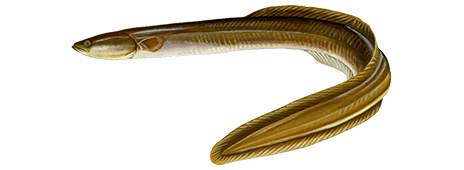
American Eel
The American eel probably has the broadest diversity of habitats of any fish species in the world.

Region
South
Catch ease
Easy
Habitat
Lake, River, Ocean
How to identify an American Eel
The body is snakelike and the head is pointed. The dorsal, caudal and anal fins are combined into one long, continuous fin. The eel’s coloration is dark gray to olive above and yellowish or white on the underside. The average size typically ranges in the range of two feet, although larger specimens may grow upwards of three feet. There have been a few rare occurrences of American eels ranging upwards of five feet.
Where to catch American Eel
The American eel, also known as the common or freshwater eel, can be found in a variety of habitats across an extensive geographic range. The American eel occurs in freshwater rivers and lakes, estuaries, coastal areas and open ocean from the southern tip of Greenland, along the Atlantic coast of North America, throughout the Gulf of Mexico and the Caribbean, to Venezuela, and inland in the St. Lawrence Seaway and the Great Lakes. The eel is an abundant resident of all tributaries to the Chesapeake Bay while in its yellow eel phase, which occurs as the eel matures. Before reaching this life-history phase, which comprises a large portion of its life cycle, the eel has undergone several physical and geographical changes. The following list includes additional details on where to catch this fish:
| Gradual Shores |
| Inlets and Outlets |
| Overhanging Trees and Bushes |
| Riparian Zones |
| Dams and Falls |
| Spring Holes |
| Undercuts |
| Holes |
| Open Water |
| Piers, Docks and Pilings |
| Rock and Boulder Pockets |
| Drop-Offs |
| Sunken Objects |
| Walkways and Bridges |
How to catch American Eel
The following are fishing methods used to catch this fish:
American Eel lures, tackle & bait
The following are lures, tackle or bait that can be used to catch this fish:
